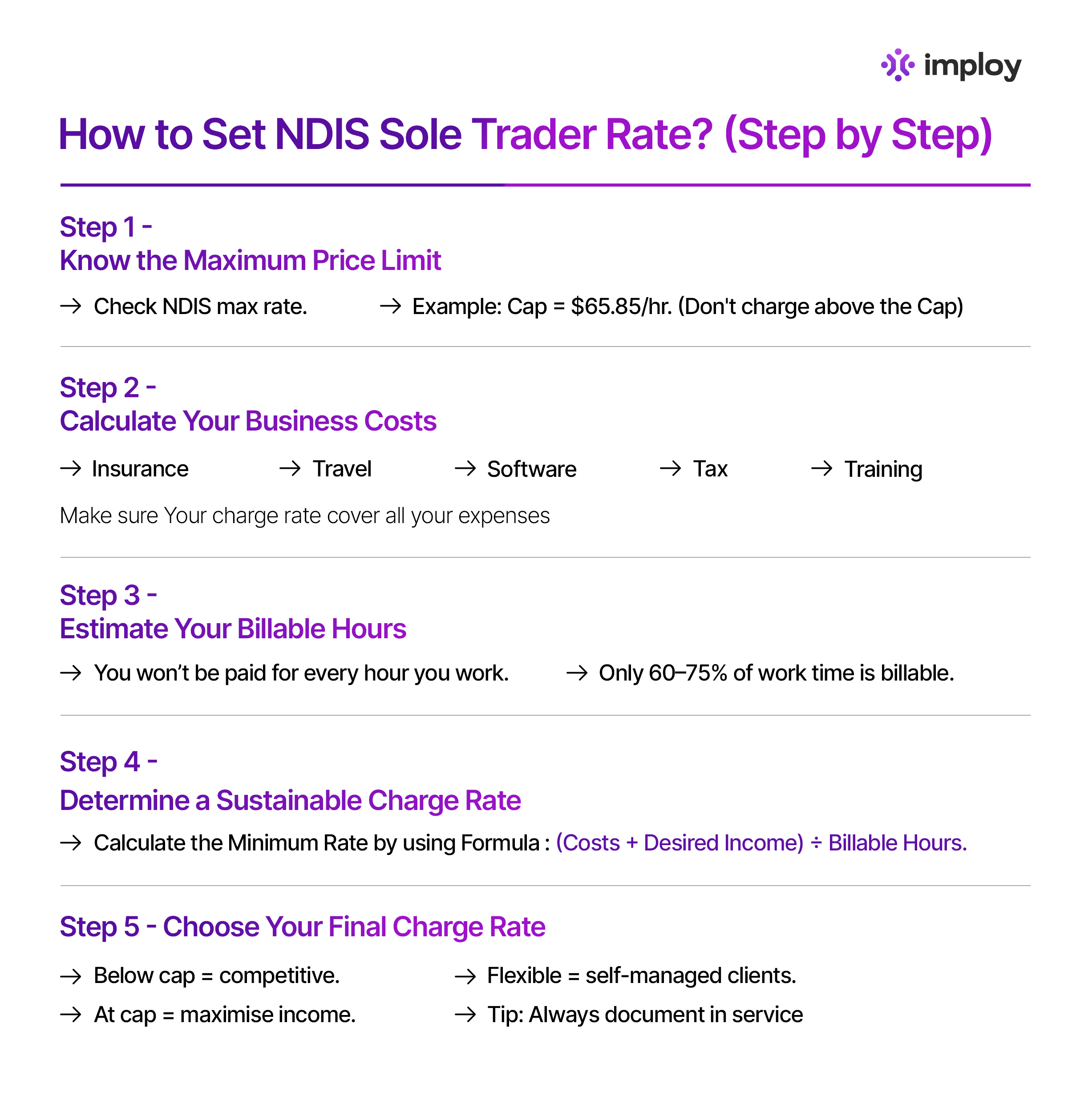NDIS Sole Trader Pay Rates: What You Need to Know in 2025
Learn how NDIS sole trader pay rates work in 2025, including price limits, cost factors, rate-setting steps, and how to stay compliant as an independent provider.

As the NDIS(National Disability Insurance Scheme) sector continues to grow, more support workers, therapists, and disability service professionals are choosing to operate as sole traders. Whether you’re an independent support worker, therapist, recovery coach, or support coordinator, one of the most important aspects of running your business is understanding NDIS pay rates.
In 2025, sole traders face a unique environment of pricing rules, flexibility, and business responsibilities. This guide breaks down everything you need to know - including how NDIS price limits work, how to set your own rates, and why sole trader rates sometimes differ from those of larger providers.
What Are NDIS Sole Trader Pay Rates?
NDIS sole trader pay rates refer to the hourly charges that self-employed providers bill for delivering NDIS-funded services. These may include:
- Core supports (e.g., daily living assistance, community access).
- Capacity-building supports (e.g., therapy, coaching, behaviour support).
- Support coordination. (Learn more about the Levels of NDIS Support Coordination).
- Allied health and therapy services.
Your pay rate is what you charge clients. Your income is what you keep after business expenses. Understanding both is essential when operating independently.
How NDIS Pricing Arrangements Work in 2025?
Every year, the NDIA publishes the Pricing Arrangements and Price Limits which outline:
- Maximum hourly rates for each support item.
- Rules about travel claims, cancellations, and non-face-to-face time.
- Worker cost model assumptions.
- Updates from the Annual Pricing Review.
These pricing limits apply equally to:
- Sole traders.
- Small providers.
- Large organisations.
- Registered or unregistered providers (if delivering price-capped supports).
There are NO separate rates for sole traders. All providers must adhere to the same maximum price limits listed in the NDIS Pricing Arrangements.
Example Pay Rates for Sole Traders (From 2025 Price Limits)
The following are indicative maximum price limits from the 2025–26 NDIS Pricing Arrangements:
These are maximums - you may charge less but never exceed these limits for capped supports.
Do Sole Traders Earn More or Less Than Other Providers?
While the NDIA sets identical maximum rates for everyone, actual earnings can differ due to business costs.
Why Sole Traders Often Charge Less?
- Fewer overheads.
- Lower admin costs.
- No large payroll burden.
- Flexibility in pricing (especially with self-managed participants).
Why Do Large Providers Charge More?
- Higher compliance, HR, and administration costs.
- Office leases, software systems, fleet vehicles.
- Structured business models.
A sole trader might charge $55/hr where a large provider charges the full $66/hr. Both are compliant - just different business models.
But the NDIS price caps themselves are identical for everyone.
How to Set Your Pay Rate as a Sole Trader?
Setting your pay rate is one of the most important decisions you’ll make as an NDIS sole trader. Your rate must not only reflect the value of your work but also cover your business expenses, stay within NDIS limits, and remain competitive in the market. A well-calculated rate ensures your business is sustainable, profitable, and compliant. Use the following 5-step framework to determine a rate that works for you.

Step 1: Know the Maximum Price Limit
Every NDIS support item has a maximum price limit (for example, $66/hr for standard support work or $183.99/hr for therapy).
This is the highest amount you can charge for price-capped supports.
Example:
If the price limit for your support item is $65.85/hr, you cannot charge $70/hr under NDIS-managed or plan-managed arrangements.
Step 2: Calculate Your Business Costs
Your charge rate must cover all your expenses - not just your time with the client.
Include things like:
- Insurance.
- Fuel, maintenance, vehicle costs.
- Accounting, software subscriptions.
- Rent, Phone and Internet.
- Travel time between shifts
- Superannuation contributions (you must pay this for yourself!)
- Annual tax amounts you’ll owe
- Equipment, PPE, training, certifications.
Step 3: Estimate Your Billable Hours
You won’t be paid for every hour you work.
Most sole traders find only 60-75% of their work time is billable because of:
- Admin & record-keeping.
- Report writing.
- Communicating with clients.
- Travel.
- Marketing.
- Quoting & onboarding.
Example:
You plan to work 40 hours per week × 46 weeks = 1,840 total hours per year.
If 65% of those hours are billable:
1,840 × 0.65 = 1,196 billable hours/year
Step 4: Determine a Sustainable Charge Rate
Use this formula:
(Total business costs + desired income) ÷ billable hours = minimum hourly rate
Let’s continue our example:
- Business costs: $22,000/year
- Desired personal income: $60,000/year
- Billable hours: 1,196 hours
Calculation:
($22,000 + $60,000) ÷ 1,196 = $68.47/hr
This means:
You need to charge at least $68.50/hour just to cover your costs and earn your target income.
Now compare that with the NDIS price limit.
If the NDIS price limit for your item is $65.85/hr, you would need to either:
- Increase your billable hours.
- Reduce business costs.
- Adjust your income expectations
- Or deliver supports with higher price limits
This step is critical - many new sole traders undercharge and accidentally operate at a loss.
Step 5: Choose Your Final Charge Rate
Once you know your minimum rate, you can choose a charge rate based on your market, experience, and client type.
Common strategies:
- Charge slightly below the NDIS cap: Good for competitiveness, especially for new providers.
- Charge at the NDIS cap: Maximises earnings and is normal for therapists, recovery coaches, and experienced support workers.
- Use flexible pricing: For example, charging a different rate for self-managed vs plan-managed clients (self-managed clients have more flexibility and can negotiate).
Whatever you choose, ensure it is:
- Compliant.
- Documented clearly in your service agreement.
- Transparent and agreed to by the participant.
By following this structured approach, you can set a pay rate that reflects your worth, covers your operating costs, and ensures your business remains healthy for years to come. A thoughtful pricing strategy is key to building a sustainable and rewarding career as a sole trader under the NDIS.
Why Sole Trader Rates Differ in Practice (Even Under the Same Price Caps)
Although there are no official differences, real-world pricing varies because:
- Sole traders may negotiate with self-managed clients.
- Larger organisations need to cover higher overhead.
- Rural/remote regions may use additional loadings.
- Experience and qualifications influence competitiveness.
- Market dynamics (supply vs demand) change pricing behaviour.
NDIS does not enforce a minimum rate - only a maximum. This is why you’ll see variations between sole traders and organisations despite identical price caps.
How to Stay Compliant While Maximising Your Earnings?
Staying compliant with NDIS rules is essential for protecting your business, ensuring you receive timely payments, and maintaining trust with participants. While sole traders have the flexibility to set their own rates (within NDIS limits), you must still follow the Pricing Arrangements and documentation requirements. Here’s how to stay compliant without compromising your income:
- Follow the NDIS price limits for capped supports: Never exceed the maximum price limit for any support item that has a capped rate.
- Use the correct support item numbers: Misclassification - whether accidental or intentional can lead to rejected claims or funding clawbacks.
- Keep detailed documentation: Good records protect you during audits and ensure you get paid quickly. Keep notes for:
- Travel
- Non-face-to-face time
- Cancelled services
- Progress notes and service logs
- Maintain transparent service agreements: Clients should always know your rate, how you charge, and what services you’ll provide. Clear agreements prevent misunderstandings and strengthen trust.
- Review your rates annually: NDIS price limits change every year (usually on 1 July), so adjusting your rates accordingly keeps your pricing competitive and compliant.
By following these practices, you can run a compliant, efficient, and profitable sole trader business under the NDIS. Strong systems and transparent communication not only protect your business, they also position you as a reliable, trustworthy provider who delivers value to participants.
Tools That Simplify Rate Management for Sole Traders
Platforms like Imploy support sole traders by offering:
- Automated NDIS-compliant invoicing.
- Up-to-date price limits integrated into the system.
- Timesheets and expense tracking.
- Faster payment processing.
- Business reports to assess hourly profitability.
For sole traders managing their own business, these tools save hours of admin and reduce compliance risk.
Common Mistakes Sole Traders Make With Pricing
Avoid these pitfalls:
- Charging too low due to fear of losing clients.
- Forgetting to include insurance and tax in cost calculations.
- Confusing billable vs non-billable time.
- Charging above price caps.
- Not updating rates when NDIS releases new pricing.
- Poor timekeeping or incomplete documentation.
A sustainable price rate protects your business and wellbeing long-term.
Final Thoughts
In 2025, NDIS sole trader pay rates remain a crucial part of building a viable and compliant business. While the NDIA sets the same price limits for all providers, sole traders often have more flexibility in what they charge, especially with self-managed participants.
By understanding the pricing framework, calculating a sustainable rate, and keeping on top of compliance, you can run a thriving sole trader business that remains both competitive and financially healthy.
If you're ready to streamline your business and stay compliant with NDIS pricing rules, Imploy is here to help.
Frequently Asked Questions
1. Do sole traders have different NDIS price limits?
No. The same NDIS price limits apply to all providers, regardless of size or structure.
2. Can sole traders charge more than the NDIS price limit?
No. The limit is strict for price-capped supports.
3. Can sole traders charge less than the price limit?
Yes. Sole traders often charge less based on market conditions and lower overheads.
4. Do self-managed clients follow the price limits?
Technically, yes - the price must be "reasonable and necessary," but self-managed participants have more flexibility in negotiating.
5. How often do price limits change?
Every financial year, with updates released around 1 July.





